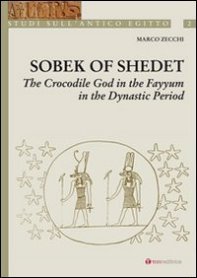
Sobek (also called Sebek), was an ancient Egyptian deity with a complex and fluid nature.He is associated with the Nile crocodile or the West African crocodile and is represented either in its form or as a human with a crocodile head. Sobek was also associated with pharaonic power, fertility, and military prowess, but served additionally as a protective deity with apotropaic qualities, invoked particularly for protection against the dangers presented by the Nile.
Sobek enjoyed a longstanding presence in the ancient Egyptian pantheon, from the Old Kingdom of Egypt (c. 2686–2181 BCE) through the Roman period (c. 30 BCE – 350 CE). He is first known from several different Pyramid Texts of the Old Kingdom, particularly from spell PT 317.The spell, which praises the pharaoh as the living incarnation of the crocodile god.
Sobek is, above all else, an aggressive and animalistic deity who lives up to the vicious reputation of his patron animal, the large and violent Nile crocodile/West African crocodile. Some of his common epithets betray this nature succinctly, the most notable of which being: "he who loves robbery", "he who eats while he also mates", and "pointed of teeth". However, he also displays grand benevolence in more than one celebrated myth. After his association with Horus and consequent adoption into the Osirian triad of Osiris, Isis, and Horus in the Middle Kingdom, Sobek became associated with Isis as a healer of the deceased Osiris.
It is from this association with healing that Sobek was considered a protective deity. His fierceness was able to ward off evil while simultaneously defending the innocent. He was thus made a subject of personal piety and a common recipient of votive offerings. Likewise, crocodiles were raised on religious grounds as living incarnations of Sobek. Upon their deaths, they were mummified in a grand ritual display as sacred, but earthly, manifestations of their patron god. This practice was executed specifically at the main temple of Crocodilopolis. These mummified crocodiles have been found with baby crocodiles in their mouths and on their backs. The crocodile – one of the few reptiles that diligently care for their young – often transports its offspring in this manner. The practice of preserving this aspect of the animal's behavior via mummification is likely intended to emphasize the protective and nurturing aspects of the fierce Sobek, as he protects the Egyptian people in the same manner that the crocodile protects its young.
Sobek first acquired a role as a solar deity through his connection to Horus, but this was further strengthened in later periods with the emergence of Sobek-Ra, a fusion of Sobek and Egypt's primary sun god, Ra. Sobek-Horus persisted as a figure in the New Kingdom.
The entire Faiyum region – the "Land of the Lake" in Egyptian (specifically referring to Lake Moeris) – served as a cult center of Sobek. Most Faiyum towns developed their own localized versions of the god, such as Soknebtunis at Tebtunis, Sokonnokonni at Bacchias, and Souxei at an unknown site in the area. At Karanis, two forms of the god were worshipped: Pnepheros and Petsuchos. There, mummified crocodiles were employed as cult images of Petsuchos.
Sobek Shedety, the patron of the Faiyum's centrally located capital, Crocodilopolis (or Egyptian "Shedet"), was the most prominent form of the god. Extensive building programs honoring Sobek were realized in Shedet, as it was the capital of the entire Arsinoite nome and consequently the most important city in the region. It is thought that the effort to expand Sobek's main temple was initially driven by Ptolemy II. Specialized priests in the main temple at Shedet functioned solely to serve Sobek, boasting titles like "prophet of the crocodile-gods" and "one who buries of the bodies of the crocodile-gods of the Land of the Lake".

